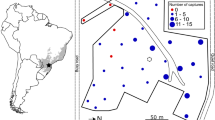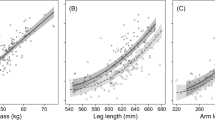Abstract
During a 15 month study on free ranging langurs (Presbytis entellus) at Jodhpur, Rajasthan, India, 5 adult male replacements were observed as a result of nontroop male invasions into the home ranges of 3 neighbouring one-male troops comprising 16–28 members each. Jodhpur langurs have no breeding season. Periods of instability during resident male changes lasted 11–119 days. Linear dominance hierarchies could be detected within the 3 main rival male bands of 2, 5, and 28–35 members. The respective alphas drove their allies away after their bands succeeded cooperatively at occupying a troop. During gradual replacements interim residencies alternated with multi-male stages. A large band's alpha may have had better chances to win the competition, since adult and nonadult allies functioned as “buffers” in agonistic encounters. The role of kin selection in structuring the composition of male bands and male coalitional behaviour cannot yet be quantified. Tactical “deceit” of powerful males to cause unrealistic expectations and in this way agonistic engagement of less strong males can be ruled out. “Sneaking copulations” is a proximate advantage for subordinate supporters, since they participated in 61.9% of all sexual interactions. Female promiscuity might reflect a strategy to induce male-male competition and thus select for a strong resident.
Similar content being viewed by others
References
Agoramoorthy G. &Mohnot S. M., 1988.Infanticide and Juvenilicide in Hanuman langurs (Presbytis entellus) around Jodhpur, India. Hum. Ev. 3: 279–296.
Bishop N., 1979.Himalayan langurs: Temperate Colobines. J. Hum. Evol., 8: 251–281.
Boggess J., 1979.Troop Male Membership changes and Infant Killing in Langurs (Presbytis entellus). Folia primatol., 32: 65–107.
Boggess J., 1980.Intermale Relations and Troop Male Membership Changes in Langurs (Presbytis entellus) in Nepal. Int. J. Primatol., 1: 233–274.
Cox C. &Le Bouef B. T., 1977.Female Incitation of Male Competition: a mechanism in Sexual Selection. Am. Nat., 111: 317–335.
Curtin R. A., 1981.Strategy and Tactics in Male Gray Langur Competition. J. Hum. Evol., 10: 245–253.
Curtin R. A., 1982.Females, Male Competition and Gray Langur Troop Structure. Folia primatol., 37: 216–227.
Hausfater G. &Hrdy S. B. (eds.), 1984.Infanticide: Comparative and Evolutionary Perspectives. New York (Aldine)
Hrdy S. B., 1974.Male-Male Competition and Infanticide among the Langurs (Presbytis entellus) of Abu, Rajasthan. Folia primatol., 22: 19–58.
Hrdy S. B., 1977.The Langurs of Abu. Cambridge, London (Harvard Univ. Press).
Jay P., 1965.The common Langur of north India. In: I. De Vore, ed. Primate Behavior — Field Studies on Monkeys and Apes, pp. 197–249. New York (Holt, Rinehart and Wiston).
Laws J. V. H. &Laws J., 1984.Social Interactions among Adult Male Langurs (Presbytis entellus) at Rajaji Wildlife Sanctuary. Int. J. Primatol., 5: 31–50.
Mohnot S. M., 1971.Some Aspects of Social Changes and Infant Killing in the Hanuman langur, Presbytis entellus (Primates: Cercopithecidae), in western India. Mammalia, 35: 175–198.
Mohnot S. M., 1974.Ecology and Behaviour of the Common Indian Langur, Presbytis entellus Dufresne. Thesis (Univ. Jodhpur).
Mohnot S. M., 1984.Some Observations on All-Male Bands of the Hanuman langur, Presbytis entellus. In: M. L. Roonwal, S. M. Mohnot, & N. S. Rathore, eds. Current Primate Researches, pp. 343–356. Jodhpur (Univ. of Jodhpur).
Moore J., 1982.Coalitions in Langur All-Male Bands. Paper presented at the IXth Congr. Int. Primatol. Soc. (Atlanta).
Moore J., 1984.Age and Grooming in Langur Male Bands (Presbytis entellus). In: M. L. Roonwal, S. M. Mohnot & N. S. Rathore, eds. Current Primate Researches, pp. 381–388. Jodhpur (Univ. of Jodhpur).
Moore J., 1985.Demography and Sociality in Primates. Thesis (Harvard Univ., Cambridge Massachusetts).
Newton P. N., 1986.Infanticide in Undisturbed Forest Population of Hanuman langurs, Presbytis entellus. Anim. Behav., 34: 785–789.
Poirier F. E., 1970.Dominance structure of the Nilgiri langur (Presbytis johnii) of south India. Folia primatol., 12; 161–186.
Rajpurohit L. S. &Mohnot M., 1988.Fate of Ousted Male Residents of One-Male-Bisexual Troops of Hanuman langurs (Presbytis entellus) at Jodhpur, Rajasthan (India). Hum. Ev. 3: 309–318.
Sommer V., 1985.Weibliche und männliche Reproduktionsstrategien der Hanuman-Languren (Presbytis entellus) von Jodhpur, Rajasthan, Indien. Thesis (Univ. Göttingen).
Sommer V., 1987.Infanticide among Free-Ranging Langurs (Presbytis entellus) at Jodhpur (Rajasthan/India): Recent Observations and a Reconsideration of Hypotheses. Primates, 28: 163–196.
Sommer V. &Mohnot S. M., 1985.New Observations on Infanticides among Hanuman langurs (Presbytis entellus) near Jodhpur (Rajasthan/India). Behav. Ecol. Sociobiol., 16: 245–248.
Sugiyama Y., 1965.On the Social Change of Hanuman langurs (Presbytis entellus) in their Natural Condition. Primates, 6: 381–418.
Sugiyama Y., 1967.Social Organization of Hanuman langurs. In: S. Altmann, ed. Social Communication among Primates, pp. 221–236. Chicago (Univ. Chicago Press).
Sugiyama Y., Yoshiba K., Parthasarathy M. D., 1965.Home Range, Mating Season, male Group and Intertroop Relations in Hanuman langurs (Presbytis entellus). Primates, 6: 73–106.
Vogel C., 1976.Ökologie, Lebenweise und Sozialverhalten der grauen Languren in verschiedenen Biotopen Indiens. Advances in Ethology, Supplements J. Compar. Ethol., 17. Berlin, Hamburg (Paul Parey).
Vogel C. &Loch H., 1984.Reproductive Parameters, Adult Male replacements, and Infanticide among Free Ranging Langurs (Presbytis entellus) at Jodhpur (Rajasthan), India. In: G. Hausfater & S. B. Hrdy, eds. Infanticide: Comparative and Evolutionary Perspectives, pp. 237–255. New York (Aldine).
Winkler P., Loch H., Vogel C., 1984.Life History of Hanuman langurs (Presbytis entellus): Reproductive Parameters, Infant Mortality, and Troop Development. Folia primatol., 43: 1–23.
Yoshiba K., 1968.Local and Intertroop Variability in Ecology and Social Behavior of Common Indian Langurs. In: P. Jay, ed. Primates: Studies in Adaptation and Variability, pp. 217–242. New York (Holt, Rinehart and Wiston).
Author information
Authors and Affiliations
Rights and permissions
About this article
Cite this article
Sommer, V. Male competition and coalitions in langurs (Presbytis entellus) at Jodhpur, Rajasthan, India. Hum. Evol. 3, 261–278 (1988). https://doi.org/10.1007/BF02435857
Received:
Accepted:
Issue Date:
DOI: https://doi.org/10.1007/BF02435857




